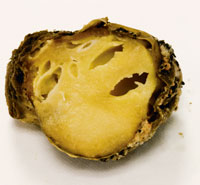Potato seed blackleg rejections double

Blackleg infections have caused double the amount of seed potato crops to be downgraded this season compared with 2010, according to Stuart Wale of the Scottish Agricultural College.
“About 8% have been downgraded, while 0.9% won’t be certified at all because of blackleg.”
The higher levels of infection were a consequence of the weather, and the late, wet harvest in 2010, which resulted in more contamination of daughter tubers and difficulty in drying potatoes going into store, he explained.
“Growers could also have spread blackleg bacteria on the grading line if they weren’t careful.”
Another wet harvest would further increase blackleg risk next season, but whatever harvest conditions, Dr Wale advised growers to ventilate crops, preferably using positive ventilation, as soon as in store. “Get them dry and keep them dry,” he said.
He also advised growers to flail potato seed crops that had not begun senescing before being ready to be destructed as the first treatment to reduce the risk of pit rot, which is also caused by the blackleg bacteria.
A small Potato Council-funded survey in 2009 had shown that if the haulm was green and the variety was prone to pit rot using diquat to desiccate the crop could lead to pit rot infections, he said.
In contrast, where growers pulverised the crop first there was less pit rot. “There were some examples, where some stocks were treated with diquat, and some were pulverised first, it was chalk and cheese in terms of seed quality.”
Further trials in 2010 had confirmed that pulverising was the best initial treatment where the haulm was not senescing. “After that it doesn’t matter what chemical treatment you use.”
Where the crop is already senescing at time of destruction then it didn’t matter how it was destroyed, he added.
Flailing was likely to be needed this season as many crops were green following late nitrogen take-up, he said. “The trouble is that it is so wet at the moment, you can’t use the flail.”
Some growers were also worried that using the flail would spread blackleg bacteria in infected haulm to tubers, he said. “It is the big question, but I think with modern flail hoods they keep the material within the hood and don’t spread downwind too far. I also don’t think spread from the haulm is as significant as it is from rotting mother tubers.”
Speedy PCN soil testing introduced
Rogueing seed potato crops cost industry £300,000
Securing potato seed export growth priority
Diquat SOLA to help control of potato dumps

